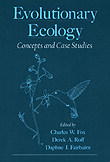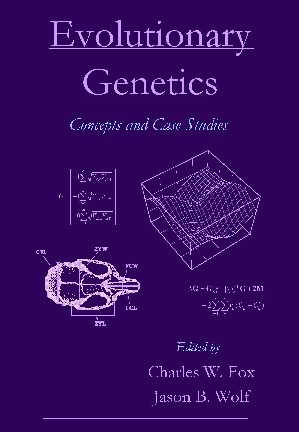|
Evolutionary Genetics: Edited by: CHARLES W. FOX, |
||
|
Charles W. Fox e–mail: fox (AT) uky.edu |
|
Jason Wolf Phone: +44 (0) 161–275–3861 email: Jason@EvoGen.org |
You can pre-order
this book from Amazon.com here
Table of
Contents
1. Principles of Evolutionary Genetics
1. From Mendel to molecules: A brief
history of evolutionary genetics – Michael R. Dietrich (
2. Genetic variation – Marta Wayne and Michael M. Miyamoto (
3. Mutation – David
Houle (
4. Natural selection – Mike Wade (
5. Stochastic
processes in evolution – John H. Gillespie (
6. Genetics and
evolution in structured populations – Charles Goodnight (
2. Molecular Evolution
7. Detecting selection at the molecular
level – Michael
Nachman (
8. Rates of molecular evolution – Francisco
Rodríguez–Trelles (Instituto
de Investigaciones Agrobiológicas
de Galicia), Rosa Tarrío (Universidad de Santiago de Compostela)
and Francisco J. Ayala (
9. Weak selection on non–coding gene
features – Ying
Chen (
10. Evolution of eukaryotic genome
structure – Dmitri Petrov (
11. New genes, new functions: Gene
family evolution and phylogenetics – Joe Thornton (
12. Gene genealogies –
Noah
Rosenberg
Box 12.1. Horizontal inheritance
3. From Genotype
to Phenotype
13. Gene function and molecular
evolution – Simon Lovell (
14. Evolution of multidomain
proteins – László Patthy (Biological Research center,
15. Evolutionary developmental biology– David L. Stern (
16. Canalization – Mark
L. Siegal (
17. Evolutionary epigenetics
– Eva Jablonka (
4. Quantitative Genetics and Selection
18. Evolutionary quantitative genetics –
Derek Roff (
19. Genetic architecture of quantitative
variation – James Cheverud (
Box 19.3. How to Perform A QTL Analysis
20. Evolution of genetic
variance–covariance structure – Patrick C. Phillips (
21. Genotype–environment interactions
and evolution – Samuel Scheiner (US National Science Foundation)
22. Genetics of
sexual selection – Allen J. Moore and Patricia J. Moore (
23. Social selection
– Steven A. Frank (
5. Genetics of Speciation
24. Patterns and
processes of speciation: The evolution of reproductive isolating barriers – Norman
Johnson (
25. Genetics of reproductive isolation
and species differences in model organisms
– Pawel Michalak & Mohamed A. F. Noor (
26. Natural hybridization – Michael L. Arnold (
27.
Population bottlenecks and founder effects – Lisa Marie Meffert (
28. Theory of phylogenetic
estimation – Ashley N.
Egan
and Keith
A. Crandall (
6. Evolutionary Genetics in Action
29. Evolutionary genetics of
host–parasite interactions – Paula X. Kover (
Box. 29.1. Arabidopsis as a model organism in evolutionary
genetics – Kentaro Shimizu (North
Carolina State University) and Michael D. Purugganan (North
Carolina State University)
Box 29.2. The coevolutionary consequences of
tolerance versus resistance
30. The evolutionary genetics of
senescence – Daniel E. L. Promislow (
31. Experimental evolution – Adam K. Chippindale (Queen’s
University)
32. Evolutionary conservation genetics –
Richard Frankham (
Glossary
This book is a companion volume to "Evolutionary Ecology: Concepts and Case Studies"

Reviews of "Evolutionary Ecology"
in Animal Behaviour, Bulletin of the British Ecological Society and the Quarterly Review of Biology
